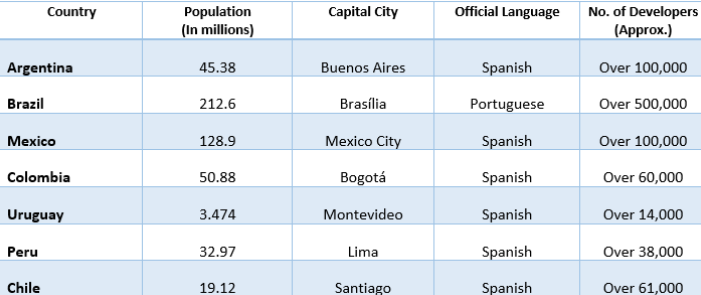How are LATAM devs meeting the Demand for Quality Developers in the US?
Table of Contents
The demand for skilled software developers in the United States has been on the rise due to the continuous expansion of the tech industry and the evolution of new technologies. However, meeting this demand has posed a significant challenge for many US companies. Fortunately, Latin America (LATAM) has emerged as a crucial player in bridging this gap by providing high-quality software development services.
Table of Contents

This article will discuss how LatAm Devs are bridging the gap and providing high-quality software development services to US companies.
1. Why LatAm Devs are a Popular Choice?
One of the key reasons why LatAm Devs have become increasingly sought after is their strong technical expertise. Many developers in LATAM possess advanced skills in programming languages, software development methodologies, and cutting-edge technologies. What is the process to hire LatAm Devs in 2024? These professionals often undergo rigorous training and education programs, ensuring that they are well-equipped to tackle complex development projects.
LATAM has a growing pool of talented developers who are fluent in English, which is essential for effective communication with US-based clients. This language proficiency enables seamless collaboration between US companies and LATAM development teams, leading to more efficient project management and delivery.
Additionally, the cost-effectiveness of outsourcing software development to LATAM is another appealing factor for US companies. While maintaining high-quality standards, LatAm Devs typically offer competitive rates compared to their counterparts in the US. This cost advantage allows businesses to reduce their development expenditures without compromising on the quality of the end product.
LATAM’s geographical proximity to the United States provides certain advantages in terms of time zone alignment and cultural affinity. These factors facilitate closer collaboration and smoother communication between US clients and LATAM development teams, minimizing potential barriers and enhancing overall project efficiency.
Overall, the combination of technical expertise, language proficiency, cost-effectiveness, and geographical proximity makes LATAM an attractive destination for US companies seeking software development services. By leveraging the talent and capabilities of LatAm Devs, US businesses can effectively meet their software development needs while remaining competitive in the rapidly evolving tech landscape.
2. Booming Tech Industry in LATAM
Latin America (LATAM) has witnessed a remarkable surge in its tech industry over the last two decades, and LatAm Devs are driving change in the digital era while transforming the region into a burgeoning hub for software development and innovation. This growth can be attributed to several factors, including increased investment in education, government initiatives promoting STEM education, and partnerships with leading organizations such as Google and Siemens.
2.1. Brief Overview
The tech industry in LATAM has experienced exponential growth, propelled by a wave of investment in education and a burgeoning interest in STEM fields. Countries such as Costa Rica, Brazil, Argentina, Mexico, and Colombia have significantly increased their expenditure on education, with a particular focus on developing skills in science, technology, engineering, and mathematics (STEM).
2.2. Factors contributing to the growth of the tech industry
Between 2000 and 2017, investment in education in LATAM increased from 3.9% to 4.5% of GDP as per the UN’s Sustainable Development Goals, with countries like Costa Rica leading the way with 7.4% of GDP dedicated to education. This investment has led to the development of national curriculum guidelines for computer science and digital literacy, equipping students with essential skills for the tech industry.

Governments across LATAM have implemented programs to promote STEM education from primary school onwards. For instance, Chile’s National Plan for Digital Languages encourages students to pursue careers in computer science and engineering by integrating computer science topics into the curriculum and providing teacher training in the field.
Several organizations including Google, IAB, and Siemens have invested in technology education in LATAM, collaborating with governments and educational institutions to foster innovation and skill development. For example, the Omar Dengo Foundation in Costa Rica has partnered with the government since 1988 to incorporate computer science concepts into the curriculum, ensuring that students are prepared for careers in the tech industry.
2.3. Increasing number of tech startups and innovation hubs
The growth of the tech industry in LATAM has spurred the emergence of numerous tech startups and innovation hubs across the region. Countries like Mexico and Brazil are witnessing a surge in the number of tech startups, fueled by a pool of highly skilled software engineers. These startups are driving innovation in various sectors, including fintech, healthcare, and e-commerce, and attracting investment from both domestic and international sources.
The booming tech industry in LATAM is a result of concerted efforts to invest in education, promote STEM fields, and foster collaboration between governments, private sector companies, and educational institutions. This growth has positioned LATAM as a key player in the global tech landscape, with its skilled developers increasingly sought after by companies worldwide.
3. Cultural Proximity and Time Zone Advantage
Latin America (LATAM) offers a unique advantage to American companies looking to outsource their development needs, stemming from cultural proximity and a favorable time zone overlap. These factors greatly facilitate collaboration and communication between LatAm Devs and US companies, contributing to smoother operations and enhanced project outcomes.
3.1. Similar cultural backgrounds and work ethics
LatAm Devs often share similar cultural backgrounds and work ethics with their counterparts in North America. This shared cultural understanding fosters a sense of cohesion and alignment in project objectives, values, and work practices. Additionally, both regions place a high value on professionalism, efficiency, and quality, further enhancing collaboration and synergy between teams.
3.2. Easier collaboration and communication with US companies
The cultural proximity between LATAM and the United States streamlines collaboration and communication between developers and clients. CloudDevs shows many reasons to why companies tend to hire LatAm Devs. Shared cultural references and communication styles reduce misunderstandings and barriers, allowing teams to focus on delivering results effectively. This ease of interaction fosters a productive working relationship built on trust, transparency, and mutual respect.
3.3. Overlapping time zones for real-time collaboration

LATAM’s geographical proximity to North America results in overlapping time zones, enabling real-time collaboration between teams. This facilitates immediate feedback, swift decision-making, and efficient problem-solving, crucial elements for agile development processes and project management. The ability to coordinate activities during regular business hours enhances productivity and accelerates project timelines, ultimately delivering value to clients.
The cultural proximity and time zone advantage offered by LatAm Devs make them an ideal choice for American companies seeking outsourcing partners. By leveraging shared cultural backgrounds, fostering seamless collaboration, and capitalizing on overlapping time zones, LatAm Devs contribute to the success of projects and drive innovation in the tech industry.
4. Meeting the Demand for Quality LatAm Devs
4.1. Outsourcing and Remote Work
- US companies outsourcing software development projects to LATAM
With the increasing demand for quality software developers in the United States, many companies are turning to Latin America (LATAM) as a strategic outsourcing destination. LATAM offers a rich pool of skilled developers who can effectively meet the diverse needs of US businesses across various industries.

- Benefits of remote work and distributed teams
Remote work and distributed teams have become increasingly prevalent, especially after the events of 2020. By leveraging remote work, US companies can tap into the global talent pool without being limited by geographical boundaries. This approach allows companies to access specialized skills and expertise that may not be readily available locally.
- Cost advantages for US companies
Outsourcing software development to LATAM provides significant cost advantages for US companies. While maintaining high-quality standards, LatAm Devs typically offer competitive rates compared to their counterparts in the US. This cost efficiency allows businesses to optimize their development budgets and allocate resources more effectively.
4.2. Talent Pool and Competitive Advantage
- Abundance of skilled developers in LATAM
LATAM boasts a thriving tech ecosystem with an abundance of skilled developers proficient in a wide range of programming languages and technologies. Countries like Brazil, Mexico, and Argentina produce a large number of software engineers annually, providing US companies with access to a vast talent pool.
- Competitive rates compared to US developers
One of the key advantages of hiring developers from LATAM is the competitive rates they offer. While maintaining high standards of quality, LatAm Devs typically charge lower rates than their counterparts in the US. This cost advantage allows US companies to maximize their return on investment and achieve greater cost-efficiency in their development projects. See the costs of hiring LatAm Devs by CloudDevs.
- Diverse skill sets and specializations
LatAm Devs bring diverse skill sets and specializations to the table, allowing US companies to find the right expertise for their specific project requirements. Whether it’s web development, mobile app development, or AI/ML solutions, LatAm Devs have the capabilities to deliver high-quality solutions tailored to the unique needs of each client.
4.3. Establishing Remote Development Centers
- Setting up dedicated development teams in LATAM

Many US companies are opting to establish dedicated development teams in LATAM to leverage the region’s talent pool and cost advantages. By setting up remote development centers, companies can build long-term partnerships with LatAm Devs and ensure continuous collaboration on their projects.
- Collaboration models and project management approaches
Establishing effective collaboration models and project management approaches is essential for successful remote development centers. US companies can leverage agile methodologies, communication tools, and project management platforms to facilitate seamless collaboration between their onshore and offshore teams.
- Successful case studies and testimonials
Numerous US companies have successfully established remote development centers in LATAM, achieving significant cost savings and improved project outcomes. Case studies and testimonials from these companies serve as a testament to the effectiveness of outsourcing to LATAM and the value it brings to their businesses.
Meeting the demand for quality developers requires US companies to leverage outsourcing, remote work, and establish remote development centers in LATAM. By tapping into the region’s abundant talent pool, competitive rates, and diverse skill sets, US companies can drive innovation, accelerate project timelines, and achieve greater cost-efficiency in their software development endeavors.
5. Overcoming Challenges and Ensuring Quality
5.1 Language and Communication
- Importance of English proficiency in the tech industry:
English proficiency is crucial in the tech industry, as it facilitates effective communication and collaboration among global teams. While many developers in Latin America (LATAM) possess strong technical skills, proficiency in English can sometimes be a challenge. However, proficiency in English is increasingly becoming a priority in LATAM’s tech education programs to bridge this gap.
- Efforts to improve language skills in LATAM:
Recognizing the importance of English proficiency, LATAM countries have been implementing initiatives to enhance language skills among tech professionals. This includes integrating English language courses into university curricula, providing language training programs for professionals, and encouraging language immersion experiences.
- Effective communication strategies and tools:

To overcome language barriers, US companies working with LatAm Devs can implement effective communication strategies and utilize communication tools. This may include providing clear project requirements and documentation, conducting regular video calls or meetings, and utilizing collaboration platforms with language translation capabilities.
5.2. Cultural and Work Style Differences
- Recognizing and addressing cultural differences:
Cultural differences between US companies and LatAm Devs can impact collaboration and project outcomes. It’s important for both parties to recognize and address these differences openly and respectfully. This may involve cultural sensitivity training, cross-cultural communication workshops, and fostering a culture of inclusivity and diversity within teams.
- Promoting cultural exchange and understanding:
Promoting cultural exchange and understanding can help bridge the gap between US companies and LatAm Devs. This can be achieved through initiatives such as team-building activities, cultural exchange programs, and creating opportunities for informal interactions and socialization among team members.
- Aligning work styles and expectations:
Aligning work styles and expectations is essential for successful collaboration between US companies and LatAm Devs. This may involve establishing clear communication channels, defining project milestones and deliverables, and setting realistic timelines and expectations. Regular feedback sessions and performance reviews can also help ensure alignment and accountability.
5.3. Quality Assurance and Project Management
- Implementing robust quality assurance processes:
Implementing robust quality assurance processes is essential for ensuring the quality of software developed by LATAM teams. This may include conducting thorough code reviews, performing automated and manual testing, and adhering to best practices and industry standards. US companies can also provide training and resources to LatAm Devs to enhance their quality assurance skills.
- Agile methodologies and project management frameworks:
Adopting agile methodologies and project management frameworks can help facilitate collaboration and transparency in software development projects. Scrum, Kanban, and other agile methodologies provide iterative development cycles, allowing teams to adapt to changing requirements and priorities. Tools such as Jira, Trello, and Asana can be used to track progress, manage tasks, and prioritize work effectively.
- Collaborative tools for tracking progress and ensuring transparency:
Collaborative tools play a crucial role in tracking progress and ensuring transparency in remote development projects. These tools enable real-time communication, document sharing, and task management, allowing teams to stay organized and aligned. Examples of collaborative tools include Slack for communication, Google Drive for document sharing, and GitHub for version control and code collaboration.
Overcoming challenges and ensuring quality in software development projects with LatAm Devs requires addressing language and communication barriers, recognizing and addressing cultural differences, and implementing robust quality assurance and project management processes. By fostering effective communication, promoting cultural exchange, and embracing agile methodologies, US companies can maximize the potential of their collaborations with LatAm Devs and achieve successful project outcomes.
Conclusion
LatAm Devs have indeed emerged as a crucial resource in meeting the escalating demand for quality developers in the United States. Their robust educational background, technical prowess, and close cultural alignment make them invaluable partners for US companies seeking software solutions of the highest caliber. Despite challenges such as language barriers and cultural disparities, concerted efforts are underway to surmount these obstacles through refined communication strategies and innovative project management approaches.
CloudDevs offers access to top-tier LatAm Devs, boasting a pool of 8000 pre-vetted professionals. Clients can benefit from the expertise of developers and designers from Latin America, paying solely for the hours dedicated to their software projects.
The collaborative synergy between US and LatAm Devs holds immense promise for the future of the tech industry. As the landscape continues to evolve and expand, this partnership is poised to thrive, presenting boundless opportunities for knowledge exchange, groundbreaking innovation, and far-reaching socioeconomic impact. By harnessing the rich talent pool and embracing cutting-edge technologies, LatAm Devs are primed to assume an increasingly pivotal role in fulfilling the ever-growing demand for top-tier developers in the US.



